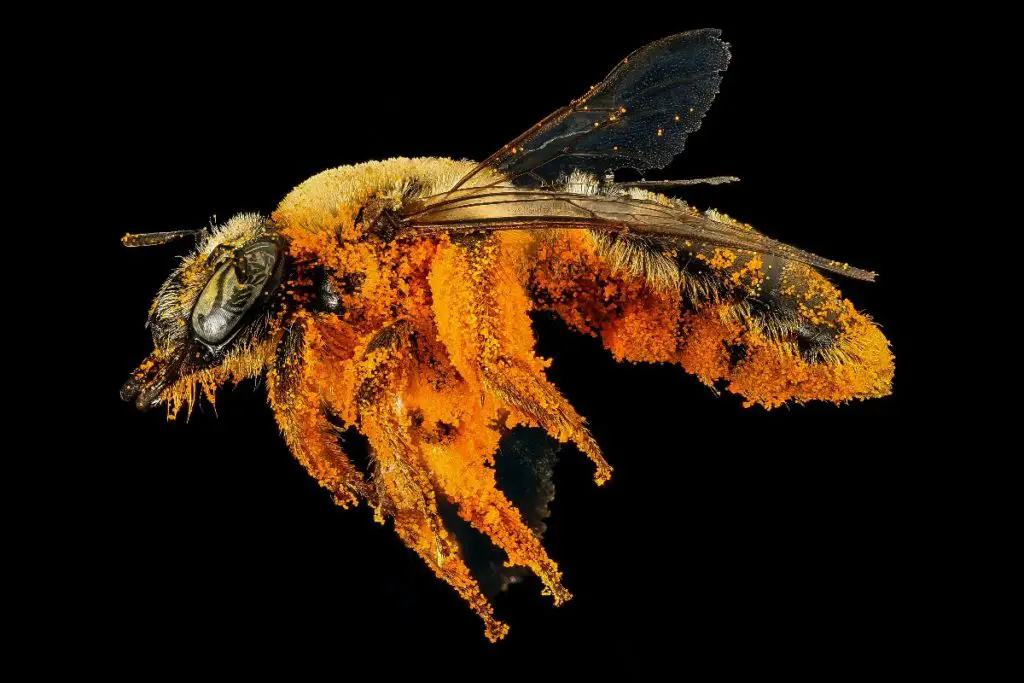Last updated on September 21st, 2023 at 12:37 pm
Have you ever looked out across a field or a meadow of wildflowers buzzing with bees and thought, why exactly are bees even collecting pollen and what do they do with it?
Let’s take a detailed look into how the bees in your garden collect pollen and what they do with it afterwards.
So Why Do Bees Collect Pollen?
Bees collect pollen because it contains a mixture of proteins, fats, vitamins, minerals, and other nutrients that are vital for the development of bee larvae.
Each of these nutrients makes up the building blocks required for a larva to develop into a healthy mature bee. Let’s take a closer look at the holy trinity of bees’ nutritional requirements.
Protein
Protein is essential for the bee’s growth and repair of body tissues, as well as for the production of enzymes and hormones.
Just like humans if we ate nothing but carbohydrates all day we wouldn’t be feeling too great.
Fats
Fats provide a concentrated source of energy that can be stored in the body. Fats are also important for the production of wax, which bees use to build their comb.
Vitamins
Vitamins are essential for a bee’s digestion, energy production, and immune function and pollen is rich in vitamin C, vitamin E, and the B vitamins.
Now we can clearly see why bees collect pollen, it’s paramount to their very survival just as much as their doing it is paramount to ours.
But to make the pollen into a substance that can be consumed by the young larvae requires a little more effort from the bees residing in the nest or hive.
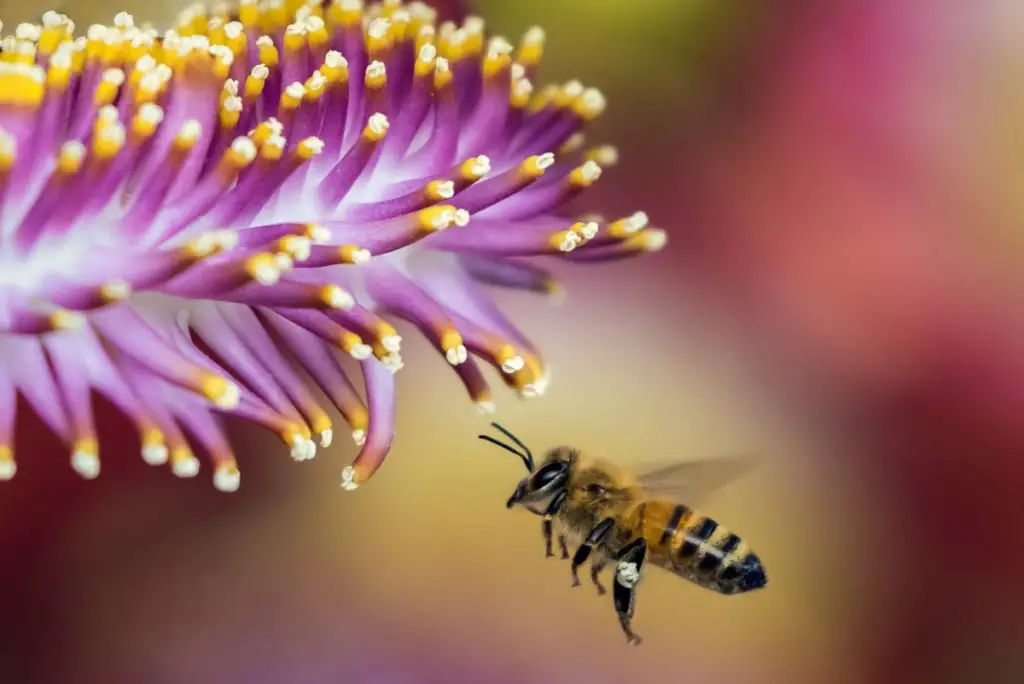
What Do Bees Do With Pollen?
Once a worker bee returns packed with pollen it transfers it over to a younger female who takes on the role of a ‘nurse bee’, tasked with feeding and nurturing the young brood.
By mixing pollen with enzymes and other secretions that they produce in their digestive tract these young bees can produce something called ‘bee bread’.
When the pollen is blended with the enzymes and secretions, including honey, nectar, and bee saliva (which help to break down the pollen) it makes the nutrients contained within more accessible to the larvae.
The nurse bees also add bacteria and yeast to the mixture which helps to ferment the pollen and improve its digestibility.
How do bees deal with bacteria in the pollen?
Unlike nectar which will later be turned into honey, pollen contains bacteria which will make it spoil over time.
The worker bees overcome this in two ways, first, they mix the pollen with secretions from their saliva adding antibacterial properties, and then the pollen will be mixed with a little honey before being packed into a cell within the honeycomb.
The packing is completed by a charming process of headbutting the pollen to compress it down into the cell before it’s finished with a final layer of honey.
The fermentation process will begin and the end result will be ‘bee bread’ otherwise known as ambrosia.
*Interesting fact – Once this amazing feat of chemistry is complete the bee will pack the bee bread into the cells of the honeycomb which line the nest where it will ferment for several days.
When ready the nurse bee will consume the bee bread before regurgitating it to feed the ever-hungry brood.
The ingenuity of bees is truly amazing, how these insects have developed what is a similar process to the way we bake our bread will never cease to astound me.
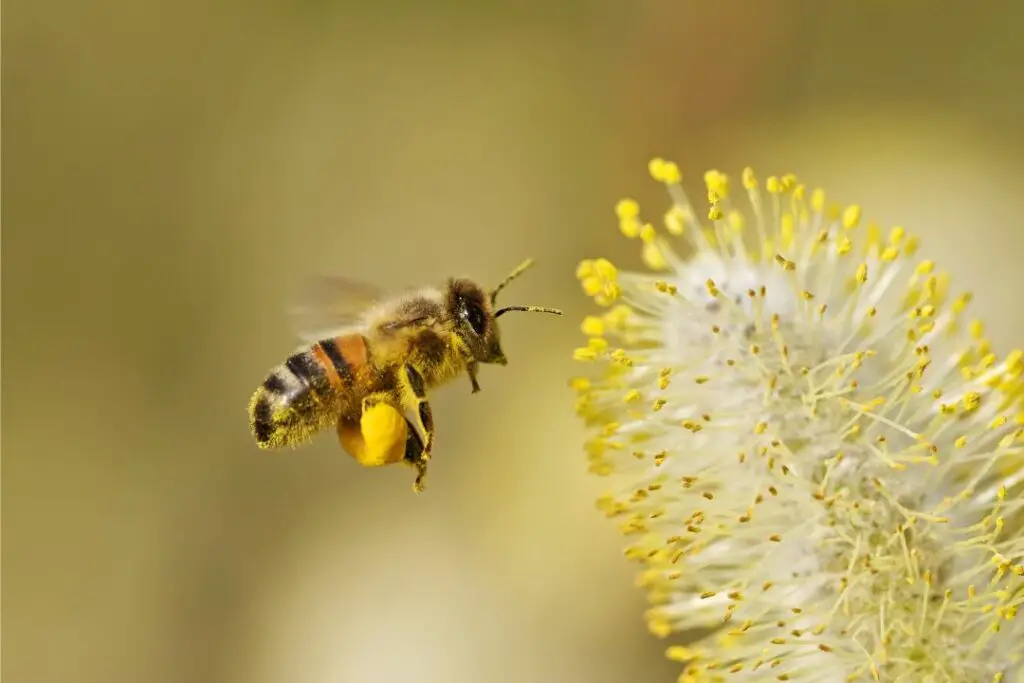
How Do Bees Find Pollen?
First of all, let’s just cover that of the three types of bees in a hive, only the female worker bee is equipped to complete the task of foraging for pollen and nectar.
A bee will leave the hive and take flight in search of precious resources.
Once in flight, the honeybee has several methods of locating and identifying swathes of flowers rich with nectar and pollen.
The waggle dance
If a bee finds a particularly nectar and pollen-rich location it’s in the interest of the whole hive that this lucky find is exploited.
Upon returning to the hive the triumphant bee will perform a form of dance known as the ‘waggle dance’.
This rather astonishing display of dance moves is performed in a figure of eight but this delightful jig carries a very important message.
The vigour of the dancing holds within it a complex code conveying far more than appears.
Each movement communicates location and distance.
This mesmerising display is normally used to locate areas rich in nectar and pollen but it’s also used by scouting bees to highlight water sources and potential new nest or hive locations when the colony swarms.
*Interesting fact – Where a worker bee is 100% certain of the validity of a new spot to forage the increased speed and energy of the waggle will naturally attract other bees to watch the display and investigate.
Flower vision
Think of all the colours of the rainbow, well imagine there are more. Crazy right?
Well for a bee that’s what vision is like. Bee’s range of vision goes well up the scale into ultraviolet colours, making them perfectly suited to spot sources of food while buzzing in the air.
This is because plants use their petals as a way to signal to pollinators.
The loud bright ultraviolet colours we can’t see shout a loud welcome to any passing bees.
These ultraviolet targets display clear instructions to the bees above, guiding them in for a safe landing and precious cargo collection.
Flowers like primroses, pansies and sunflowers all have ultraviolet landing strips leading bees directly to the precious resources found within.
Finding pollen with an electrical charge
Flowers emit a tiny negative static charge that can be sensed by the bees flying overhead.
Tiny hairs on the bee’s legs can sense electrical fields that in turn send a message to their nervous system.
This guides the bee directly towards its target and the pollen and nectar contained within.
*Interesting fact – Due to the bee’s positive charge, there is a tiny zap when the bee lands on its target flower.
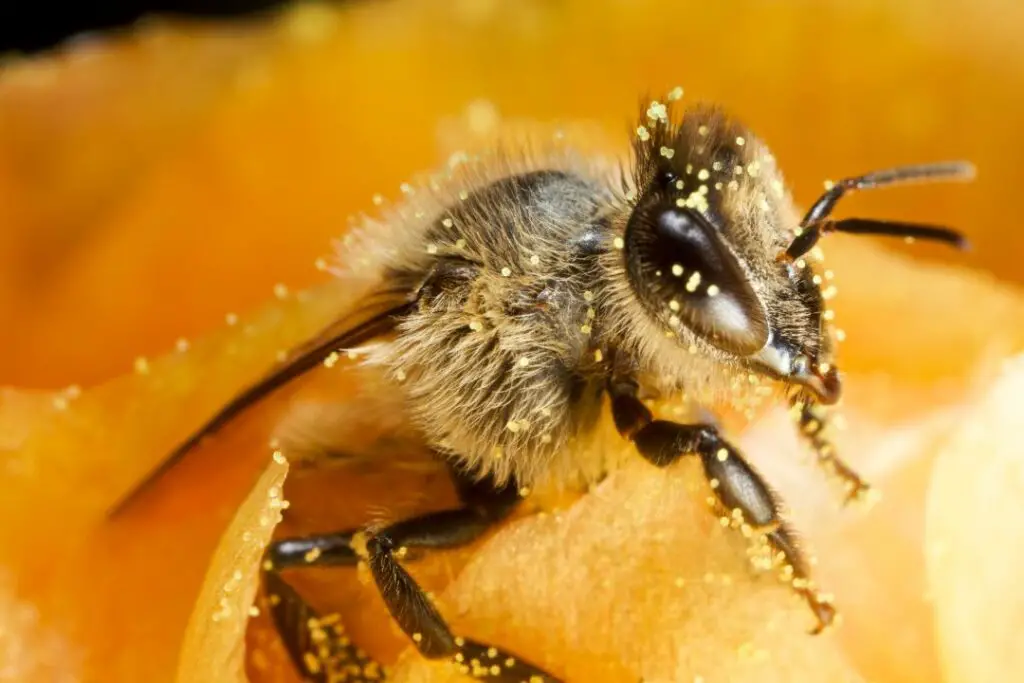
How Do Bees Collect Pollen?
Bees collect pollen by visiting flowers and using specially adapted body parts to gather pollen grains.
It all begins when a bee lands on a flower to probe the centre of the flower with its mouthparts, called a proboscis.
As the bee probes, the flower’s stamens release pollen grains which get stuck to the bee’s fuzzy body, making for the classic image of a bee covered in orange specks.
But bees can also collect pollen with a specially adapted structure called a pollen basket or corbicula, they use their legs to scrape the pollen grains from their bodies and pack them tightly into the basket.
Let’s take a quick look at how different kinds of bees approach collecting pollen.
Honeybees
The honeybee is well known for its remarkable ability to collect large quantities of pollen.
They use their proboscis to gather nectar before switching to their mandibles to scrape pollen from the anthers of flowers.
They store all the collected pollen on their hind legs in pollen baskets. These are specialized structures made of long hairs that create a concave area on each hind leg.
Bumblebees
Bumble bees use their strong mandibles to cut through petals and access the anthers tucked away inside the flower.
Just like honeybees, bumblebees store pollen in at corbicula, made up of a series of curved bristles that hold the pollen in place.
Solitary bees
Solitary bees don’t live in colonies so each female bee is responsible for collecting all the pollen she needs to raise her own offspring.
Solitary bees use a wide variety of techniques from using their legs to brush pollen from flowers to specialized hairs on their bodies that help them collect and transport pollen.
So with bees doing all this hard work let’s look at why it’s so integral to their survival and ours.
Why Is Pollination So Important?
Pollination happens when the male part of a flower (the stamen) is transferred to the female part of the same or a different flower (the stigma). This is crucial for the survival of many plant species and, consequently, for the survival of many animals, including us humans.
Here are some reasons why pollination is so damn important:
- Reproduction: Pollination lets plants reproduce and produce seeds. Without pollination, many plants would die and quickly become extinct.
- Genetic diversity: Pollination helps maintain genetic diversity, when pollen from one plant fertilizes the ovules of another plant, it introduces new genetic traits into the offspring, which helps them adapt to changing environmental conditions (global warming being one).
- Food production: Pollination is absolutely essential for the production of many fruits, vegetables, and nuts that we rely on for food. This includes some of my personal favourites like almonds, apples, and blueberries.
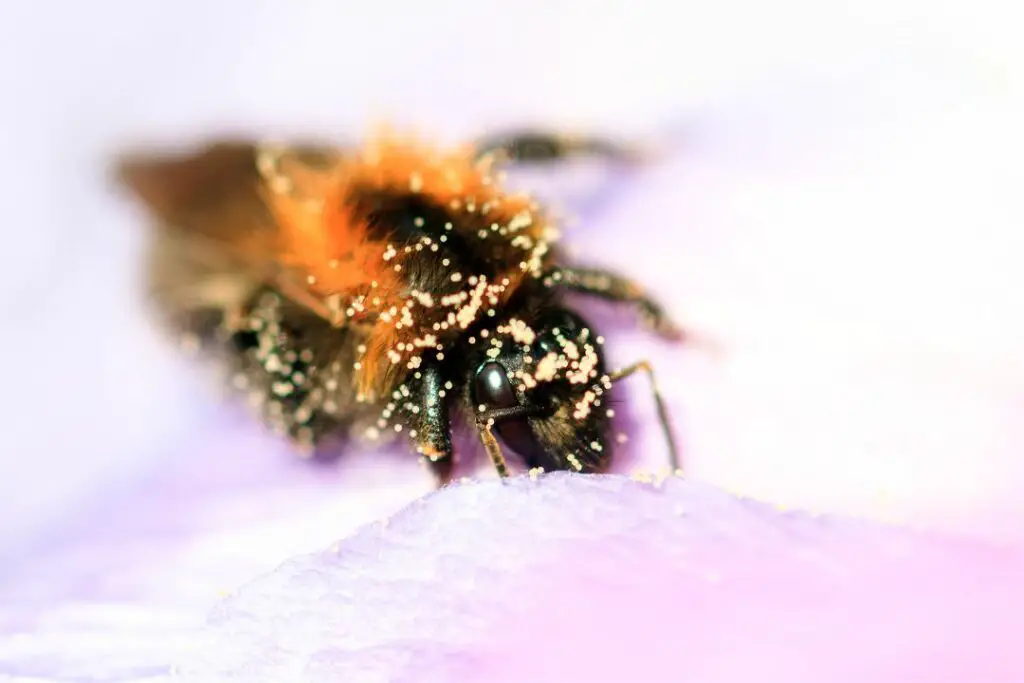
Conclusion
I truly believe bees are some of the most fascinating creatures on our planet.
Their hard work and dedication not only benefit plants but also provide us with delicious and nutritious food that many of us couldn’t live without.
By understanding and appreciating the importance of bees and their pollination efforts, we can all contribute to the preservation of our environment and the sustainability of our food sources.
So, the next time you see a bee buzzing around a flower, take a moment to appreciate the delightful day of a bee and the valuable contribution it’s making to our world.
If you’ve enjoyed this read don’t miss our other intriguing dives into the world of bees and the wildlife in your garden.

